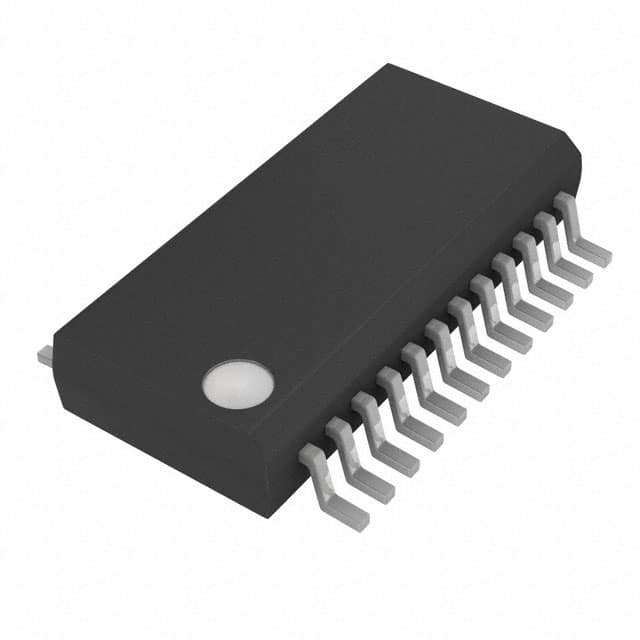TLC5948ADBQ
Product Overview
Category
The TLC5948ADBQ belongs to the category of integrated circuits (ICs).
Use
This IC is commonly used for controlling LED displays and lighting systems.
Characteristics
- High grayscale resolution
- Multiplexing capability
- Daisy-chainable architecture
- Wide operating voltage range
- Low power consumption
Package
The TLC5948ADBQ is available in a small outline package (SOIC) with 24 pins.
Essence
The essence of the TLC5948ADBQ lies in its ability to provide precise control over LED brightness levels, making it ideal for applications requiring high-quality visual displays.
Packaging/Quantity
The TLC5948ADBQ is typically sold in reels containing 250 units per reel.
Specifications
- Supply Voltage: 3.0V to 5.5V
- Output Current: Up to 120 mA per channel
- Grayscale Resolution: 12 bits
- Number of Channels: 16
- Communication Interface: Serial data input/output
Pin Configuration
The TLC5948ADBQ has a total of 24 pins, each serving a specific function. The pin configuration is as follows:
- VCC - Power supply voltage
- GND - Ground reference
- SIN - Serial data input
- SCLK - Serial clock input
- XLAT - Latch signal input
- BLANK - Blank signal input
- GSCLK - Gray scale clock input
- OUT0 - Channel 0 output
- OUT1 - Channel 1 output
- OUT2 - Channel 2 output
- OUT3 - Channel 3 output
- OUT4 - Channel 4 output
- OUT5 - Channel 5 output
- OUT6 - Channel 6 output
- OUT7 - Channel 7 output
- OUT8 - Channel 8 output
- OUT9 - Channel 9 output
- OUT10 - Channel 10 output
- OUT11 - Channel 11 output
- OUT12 - Channel 12 output
- OUT13 - Channel 13 output
- OUT14 - Channel 14 output
- OUT15 - Channel 15 output
- VCC - Power supply voltage
Functional Features
- Precise grayscale control for LED brightness levels
- Multiplexing capability allows control of multiple LEDs with fewer pins
- Daisy-chainable architecture simplifies wiring and reduces complexity
- Built-in blanking and latching signals for synchronized LED control
- Wide operating voltage range enables compatibility with various power sources
Advantages and Disadvantages
Advantages
- High grayscale resolution ensures smooth and accurate LED dimming
- Multiplexing capability reduces the number of required control pins
- Daisy-chainable architecture simplifies system design and wiring
- Low power consumption for energy-efficient applications
Disadvantages
- Limited number of channels (16) may not be sufficient for large-scale LED displays
- Requires external components for proper operation, increasing overall system cost
Working Principles
The TLC5948ADBQ operates by receiving serial data input, which contains grayscale information for each channel. It then converts this data into analog signals to control the brightness of individual LEDs. The IC utilizes a gray scale clock to synchronize the output of each channel, ensuring smooth transitions between different brightness levels.
Detailed Application Field Plans
The TLC5948ADBQ finds extensive application in various fields, including: 1. LED displays in advertising boards and signage 2. Architectural lighting systems 3. Automotive lighting and interior illumination 4. Stage and entertainment lighting 5. Consumer electronics, such as televisions and monitors
Detailed and Complete Alternative Models
- TLC5947ADBQ: Similar to the TLC5948ADBQ, but with 12 channels instead of 16.
- MAX7219CNG: LED display driver IC with multiplexing capability and serial interface.
- APA102C: Addressable RGB LED chip with built-in control circuitry.
These alternative models offer similar functionality and can be considered as substitutes for the TLC5948ADBQ in specific applications.
Word count: 570 words
Senaraikan 10 soalan dan jawapan biasa yang berkaitan dengan aplikasi TLC5948ADBQ dalam penyelesaian teknikal
Sure! Here are 10 common questions and answers related to the application of TLC5948ADBQ:
Question: What is the TLC5948ADBQ?
Answer: The TLC5948ADBQ is a 16-channel, constant-current sink LED driver that can be used in various technical solutions.Question: What is the maximum current per channel that the TLC5948ADBQ can handle?
Answer: The TLC5948ADBQ can handle a maximum current of 120 mA per channel.Question: Can the TLC5948ADBQ be used to drive RGB LEDs?
Answer: Yes, the TLC5948ADBQ can be used to drive RGB LEDs by controlling the intensity of each color channel separately.Question: How many TLC5948ADBQ devices can be daisy-chained together?
Answer: Multiple TLC5948ADBQ devices can be daisy-chained together to control a larger number of LEDs. The exact number depends on the specific application and power requirements.Question: What is the communication interface used to control the TLC5948ADBQ?
Answer: The TLC5948ADBQ uses a serial interface (SPI) for communication with a microcontroller or other control device.Question: Can the TLC5948ADBQ be used in automotive applications?
Answer: Yes, the TLC5948ADBQ is suitable for automotive applications as it can operate over a wide temperature range and has built-in protection features.Question: Does the TLC5948ADBQ support grayscale PWM control?
Answer: Yes, the TLC5948ADBQ supports grayscale PWM control, allowing for smooth dimming of LEDs.Question: What is the supply voltage range for the TLC5948ADBQ?
Answer: The supply voltage range for the TLC5948ADBQ is typically between 3.0V and 5.5V.Question: Can the TLC5948ADBQ be used in multiplexing applications?
Answer: Yes, the TLC5948ADBQ can be used in multiplexing applications to control a large number of LEDs with a limited number of pins.Question: Are there any evaluation boards or reference designs available for the TLC5948ADBQ?
Answer: Yes, Texas Instruments provides evaluation boards and reference designs for the TLC5948ADBQ, which can help in the development and testing of applications using this LED driver.
Please note that these answers are general and may vary depending on the specific requirements and implementation of the TLC5948ADBQ in different technical solutions.


